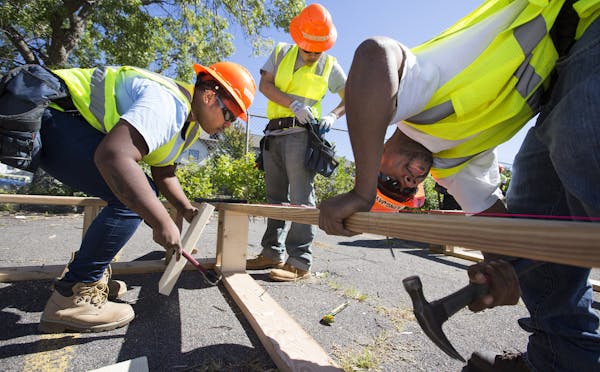As the costs of the multimillion-dollar Jackson Street and Palace Theatre projects in downtown St. Paul have grown, so has frustration among East Side leaders who say their community is not getting its fair share of city money.
The priorities of people living on the East Side, which includes some of the city's poorest and most diverse neighborhoods, have been ignored as other big-ticket projects have moved forward, community and political leaders said Thursday.
They noted that the area desperately needs places for young people to hang out after school and on weekends, but that recreation centers have limited hours and need upgrades.
City Council Members Jane Prince and Dan Bostrom on Thursday pointed to a University of Minnesota study they said backs up their refrain that the communities they represent are not getting a good deal.
The East Side has been funded at a lower per-capita rate than the rest of the city when it comes to Capital Improvement Budget money, according to the study done by researchers at the Center for Urban and Regional Affairs. Residents of that area make up 33.5 percent of St. Paul's population, but over the past decade have received about 19 percent of the city's Capital Improvement Budget funds, the study found. Those funds go toward infrastructure improvements, community facilities, and residential and economic development.
Tonya Tennessen, spokeswoman for Mayor Chris Coleman, said the study does not include many other sources of funding that went to the East Side. It is also a snapshot in time that started after big investments in the Payne-Phalen neighborhood, she said.
"The problem with this report is it's just an incomplete and misleading picture about investment on the East Side," Tennessen said.
John Vaughn, executive director of the East Side Neighborhood Development Company, prompted the University of Minnesota study by submitting a proposal to the center asking researchers to dig into the issue. He said the findings are "a piece of the pie" that could lead to changes in city spending. He said he also wants to find out where other city funding, including money from the state and federal governments and Metropolitan Council, ends up.
Vaughn said he was prompted to act when the Wilder and Scheffer recreation centers received less funding than requested, despite strong community support.
"I knew I couldn't fight a specific decision like that," he said. "So we decided if we can't win the battle, then maybe this study can help us win the war."
Bostrom and Prince questioned why the city cannot find money for such East Side needs but is able to cover millions of dollars of unexpected increases in the Palace Theatre renovation and the Jackson Street reconstruction downtown. Both projects were part of the Capital Improvement Budget.
The report recommended changes to the scoring process for projects seeking money from the Capital Improvement Budget and Neighborhood STAR, another city program that supports capital improvements.
People who serve on the committees that score the proposed projects should consider racial equity when making decisions, the report states. Geographic balance should be considered when reviewing proposed Capital Improvement Budget projects, and committee members should be provided with data on the demographic and economic makeup of districts in St. Paul, researchers recommended.
City staff members have been talking with the Capital Improvement Budget Committee about equity issues for the past couple years and had those discussions as recently as Monday, Tennessen said.
They are in the "process of evolving," she said, and announcements about that evolution will come in the next month.
Jessie Van Berkel • 612-673-4649
In heated western Minn. GOP congressional primary, outsiders challenging incumbent

Longtime St. Cloud City Council member Carol Lewis to run for mayor
DFL state senator charged with first-degree burglary in break-in at stepmother's home
![Vikings running back Dalvin Cook (33) watched during training camp Wednesday. ] ANTHONY SOUFFLE • anthony.souffle@startribune.com](https://arc.stimg.co/startribunemedia/ZHKH7NZVBNL2RFYGUCXADSN6IA.jpg?h=91&w=145&fit=crop&bg=999&crop=faces)
Former Viking Dalvin Cook, ex-girlfriend settle lawsuit for unspecified amount

